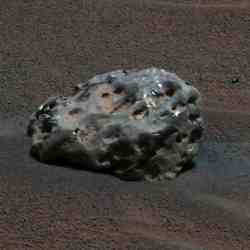
Meteorite. Image credit: NASA/JPL/Cornell Click to enlarge
A U of T scientist has found unexpectedly ?young? material in meteorites ? a discovery that breaks open current theory on the earliest events of the solar system.
A paper published today in the August issue of Nature reports that the youngest known chondrules ? the small grains of mineral that make up certain meteorites ? have been identified in the meteorites known as Gujba and Hammadah al Hamra.
Researchers who have studied chondrules generally agree that most were formed as a sudden, repetitive heat, likely from a shock wave, condensed the nebula of dust floating around the early Sun. Thinking that an analysis of the chondrules in Gujba and Hammadah al Hamra would be appropriate for accurately dating this process, U of T geologist Yuri Amelin, together with lead author Alexander Krot of the University of Hawaii, studied the chondrules? mineralogical structure and determined their isotopic age. ?It soon became clear that these particular chondrules were not of a nebular origin,? says Amelin. ?And the ages were quite different from what was expected. It was exciting.?
Amelin explains that not only were these chondrules not formed by a shock wave, but rather emerged much later than other chondrules. ?They actually post-date the oldest asteroids,? he says. ?We think these chondrules were formed by a giant plume of vapour produced when two planetary embryos, somewhere between moon-size and Mars-size, collided.?
What does this mean in the grand scheme of things? The evolution of the solar system has traditionally been seen as a linear process, through which gases around the early sun gradually cooled to form small particles that eventually clumped into asteroids and planets. Now there is evidence of chondrules forming at two very distinct times, and evidence that embryo planets already existed when chondrules were still forming. ?It moves our understanding from order to disorder,? Amelin admits. ?But I?m sure that as new data is collected, a new order will emerge.?
Financial support for this project was provided by NASA and the Canadian Space Agency.
Original Source: University of Toronto
